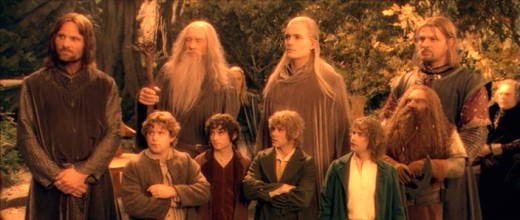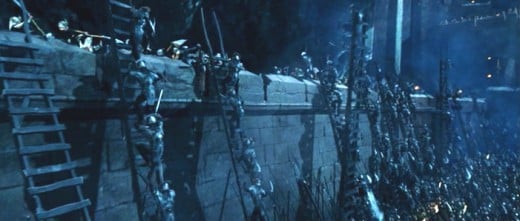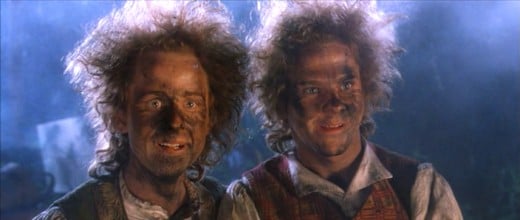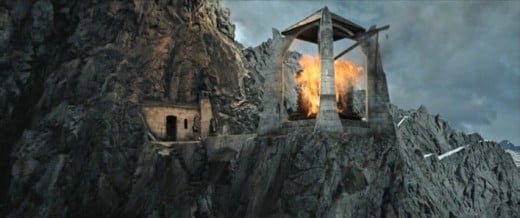- HubPages»
- Entertainment and Media»
- Movies & Movie Reviews»
- Science Fiction & Fantasy Films
The Lord of the Rings - The icon that keeps iconing

Okay, so to get back to my usual film reviews and away from my month-long Merry-thon, I've decided to talk about a very popular trilogy: The Lord of the Rings.
This also dovetails with another running interest of mine: Text to Film Adaptation.
I know I could probably cover each film in three different hubs, but considering the fact that they really aren't unique, self contained stories—the fact that the three together tell one complete, epic-scale tale—plus the fact that the books they're based on were originally intended to be published as one longer-than-the-bible-on-steroids novel, I figured it would be perfectly appropriate to cover them as a unit.
Plus, they were all filmed at the same time anyway. Principle photography at least.

If you really need a synopsis, The Lord of the Rings is set in a place called Middle-earth. The world where mid-life crises come from.
Bilbo (Ian Holm) is a hobbit. They're a quiet, peace-loving, unassuming race. Except that Bilbo once had an amazing adventure and longs to have one again. Gandalf (Ian McKellen) should have known better than to feed a stray hobbit.


Anyway, Bilbo has a nephew, Frodo (Elijah Wood). Bilbo leaves one night, right after his eleventy-first birthday. (Hobbits are childish with words that way.) Frodo learns that the ring his dear loving uncle left him is the most evil artifact in all of middle-earth and the one thing that the evil Sauron wouldn't hesitate to kill everyone around to find. Thanks uncle.
Frodo and his friends Sam (Sean Astin), Pippin (Billy Boyd), Merry (Dominic Monaghan), Happy, Dopey and Doc go on a trip to take the ring to Elrond (Hugo Weaving) who should know how to destroy it. The decision is made to bring the ring to Mordor—the only place where the ring can be destroyed. The hobbits team up with two humans, Aragorn (Viggo Mortensen) and Boromir (Sean Bean), the elf Ladylike and the Dwarf Grumpy. Sorry. I mean Legolas (Orlando Bloom) and Gimli (John Rhys-Davies).


Along the way, they meet a flaming balrog who seems to have a thing for Gandalf, a crazy old King with Doctor McCoy for a nephew, a treacherous wizard with a terribly evil Magic 8 Ball, and a bald waif with a hacking cough, a split personality and a jewelry fetish.
The first movie, The Felowship of the Ring, is mostly about putting together the group that would carry and destroy the ring. The movie even ends right as that fellowship, already shaken by the loss of one of their party earlier in the movie, finally splinters into three groups.
The second movie, The Two Towers, largely focuses on the siege of Helm's Deep. Saruman (Christopher Lee) sends his Uruk-hai to Rohan to destroy the Rohirim while Aragorn, Legolas and Gimli (and sort of Gandalf) stay to help.

It's also interesting to look at which two towers the title is referring to. There are several towers in Middle-earth worth noting: Orthanc (Saruman's tower), Minas Morgul (the dead city in Mordor), Barad-dûr (the fortress of Sauron), Minas Tirith (the Capital of Gondor), and the Tower of Cirith Ungol (the watchtower where Frodo climbed the steps toward Shelob's lair).

Tolkien has stated that he specifically left it ambiguous, though at other times he has alternately stated that the titular towers were Orthanc and Barad-dûr, Barad-dûr and Minas Tirith, or Orthanc and the Tower of Cirith Ungol. However there's a fair reason to consider that the towers in question are actually Minas Morgul and Orthanc.
But that's a bit of a nerd digression there.

Anyway, the third movie, The Return of the King, is about the sieige of Gondor and the final destruction of the ring. All the surviving fellowship but Sam and Frodo help fight off Sauron's forces while the very dynamic duo sneaks into Mount Doom and give it the finger.
They're very well made and great movies in their own right. But if you take on something as iconic and influential as The Lord of the Rings, it's inevitable that your results are going to be scrutinized and compared to the original novels from which they sprang. Considering everything they had to sift through to get where they ended up, they did a wonderful job at paring the stories down to their primary essence.
But still ... you know.

There will be those who complain about the omission of Radagast the Brown—a colleague of Gandalf and Saruman who clearly picked up his nick name after an embarassing event in junior high. Or there's Tom Bombadil along with his wife, Goldberry, and the Old Forrest. Or the Barrow-wights.
While Bombadil, Radagast and Goldberry never do make an appearance, Old Man Willow has been moved, in spirit, from the Old Forrest to Fangorn where Merry and Pippin are nearly eaten by a tree in the extended edition and saved by Treebeard (John Rhys-Davies).

In the end, most of these cuts only matter if you're a fan of that specific scene or character in the book. It would be a real stretch to make the case that they really made the book what it is today.
In fact, scenes like the ones with Bombadil actually serve to dilute the story a bit and harken back to the tone that was used in The Hobbit. It's a little like Mark Twain going from The Adventures of Tom Sawyer to The Adventures of Huckleberry Finn. The tone in Sawyer is fun and light. In Huckleberry Finn, Twain deals with some pretty heavy content. As the book ends, however, Twain brings back Tom Sawyer and the tone lightens up dramatically. Apparently Twain felt—and it's debatable how justified he was—that the book was getting way too heavy and it had to lighten up.

As Tolkien was starting his Middle-earth epic, we can still see remnants of The Hobbit in his writing and plotting. The Hobbit was mostly a series of small adventures strung together. That's what Tom Bombadil is. As it goes on, the little adventures become deeper and more entrenched with the main story in a way that Bombadil was not. In adapting The Lord of the Rings into a movie, the decision was made to keep that focus from the beginning.
Sorry 'bout that Tom. But it's much like how most adaptations of Huckleberry Finn cut Tom Sawyer from the ending to keep from weakening the dramatic punch. For instance, the 1993 Disney version The Adventures of Huck Finn, coincidentally also starring Elijah Wood.

So, if relatively small characters or scenes can be cut without hurting the adaptation, what else is there to cut, or do we really have to accept the book as our screenplay?
One thing that is enormously big in the book—and may be said to have tainted fantasy ever since—is the tremendous immersion of culture and mythology that Tolkien was able to accomplish. There are stories, and back-stories, and songs, and long legends. Many of which emphasize the atmosphere but do not establish it. It makes the world feel real, but at times it also makes the book read like a history book.

Not that that's necessarily bad. The Silmarillion actually is a history book of Middle-earth, published after Tolkien's death and made up of mythopoeic stories written by him in an effort to understand and remember the history that he himself created. It's not the best read, but it's still popular among his fans.

All that historical back-story and ethnic omnipresence is not put into the movies in the same way as in the book, but when you see the different cultures, you can't help but believe that there is a real history to the world you see. Each culture has a different design ethic and a distinct look to it. The horse motif of the Rohirim or the wings of Gondor. These are things that are always seen, take no time away from the on-screen events or dialog and serve to give a real ethos to the characters.
I say this richness of history has tainted fantasy largely because ever since its publication, fantasy writers seem to feel that they must fill their book with every bit of history that they created for that world. This can become very boring. And time consuming, if you truly want to create a world as fully realized as Middle-earth. Yes Tolkien did it. But he was a professor of language and literature. And even so, it still took him years to develop the mythology of Middle-earth and he didn't even put all of that into his books.
Also he's largely known for writing four books. (Five if you include the Silmarillion.) That's four books from a lifetime of work. How many authors really want that legacy? Especially if they only publish four books that keep people saying, "Wow, that's a lot like The Lord of the Rings."
One thing in the movies that I would complain about, however, may be the use of Gimli.

He's a great character in the book, and in the movie he's still wonderful thanks to the great performance of John Rhys-Davies. However, he's also become a bit of a punchline. I don't necessarily begrudge the filmmakers completely. The story is so heavy it needs a bit of lightness from time to time. And John Rhys-Davies plays the proud-yet-affable Gimli so well that it's hard not to take a few pot shots at the good natured character.

But what I would have done is throw a few more of those jabs at Legolas. I like him well enough most of the time, but there are just a few times where he seems way too "can-do-no-wrong". Maybe a few more jabs at his expense would have helped me with his character. I just find that I like the dwarf who takes a ribbing yet still stands his ground better than the elf that nobody challenges.
But that's a minor complaint.

And I haven't even begun to talk about Gollum (Andy Serkis). Smeagol does what Jar Jar convinced us was impossible: made a CG character that people could accept and believe and not want to gouge our own eyes out for having seen it.
The technology will only get better from here, but Serkis and Weta deserve major props for what they accomplished. It also served to launch Serkis' new career as the man whose performances will define a generation while nobody ever even sees him on screen himself. He now has King Kong and Caesar under his belt as well and I'm sure there are many more to come.
The Hobbit
Now, I'm sure that many of you have heard about the adaptation of The Hobbit that is being made right now. Split into multiple movies, no less. You may have even seen the trailer that was just released.
I was excited when Guillermo del Toro was brought on to direct. I was very looking forward to seeing the visual take he would bring to the world. Like or lump the Hellboy movies (you can try to guess which camp I'm in if you wish), they were visually very distinct and creative.
And I had no problem with the fact that Peter Jackson wasn't going to direct.
I have nothing specifically against what he did with the LOtR trilogy. But The Hobbit is not The Lord of the Rings. And personally I think it may do it an injustice to treat it as if it were.
And once del Toro left and Jackson took up directing, I remained hopeful. Del Toro helped design the look of the movie though he will not be around to execute it. My only hope is that they don't try to turn The Hobbit into The Lord of the Rings. You don't film Tom Sawyer as if it were Huckleberry Finn. You don't make The Philosopher's Stone as if it were The Deathly Hallows.
A story is its own thing and must be treated as such.
But I remain hopeful.
For me, this trilogy gets the following rating(s):
The Fellowship of the Ring - 8 / 10.
The Two Towers - 9 / 10.
The Return of the King - 8 / 10. (Though the extended cut of this last one gets a 7 / 10. This is mostly because the added footage, while lending depth to the world, also tends to break the pacing a bit and drag out a movie that already suffers from waaay too many endings. I still strongly suggest the extended edition of all three to any true Tolkien fan.)
All three movies—The Lord of the Rings: The Fellowship of the Ring, The Lord of the Rings: The Two Towers, and The Lord of the Rings: The Return of the King—are rated PG-13 for action, battle violence and scary imagery.










